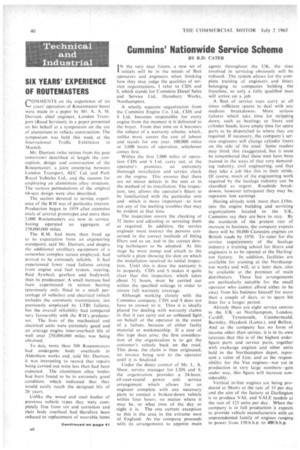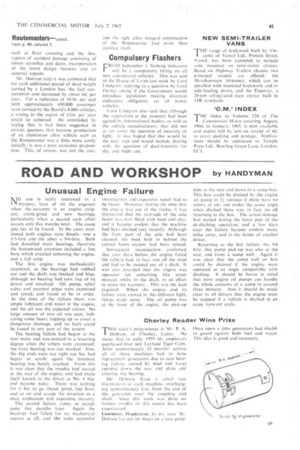SIX YEARS' EXPERIENCE OF ROUTEMASTERS
Page 42

Page 43

If you've noticed an error in this article please click here to report it so we can fix it.
COMMENTS on the experience of six ‘-•• years" operation of Routemaster buses were made in a paper by Mr. A. A. M. Durrant, chief engineer, London Transport (Road Services). in a paper presented on hi S behalf at a symposium on the use of aluminium in vehicle construction. The symposium was held this week at the International Traffic Exhibition in Munich.
Mr. Durrant (who retires from his post tomorrow) described at length the conception, design and construction of the Routemaster. a joint enterprise between London Transport, AEC Ltd. and Park Royal Vehicles Ltd.. and the reasons for employing an aluminium alloy structure. The various permutations of the original 64-seat design were also described.
The section devoted to Service experience of the RM was of particular interest. Production began in 1959 after extensive trials of several prototypes and more than 2,000 Routemasters are now in service. having operated an aggregate of 250,000,000 miles.
The R.M. had more than lived up to its expectation from an engineering standpoint, said Mr. Durrant, and despite the additional aneilliary equipment of a somewhat complex nature employed, had proved to be extremely reliable. It had experienced fewer road failures arising from engine and fuel system, steering. fluid flywheel, gearbox and bodywork than its predecessor. A small increase had been experienced in saloon heating (previously only fitted in a small percentage of vehicles) and electrical (which includes the automatic transmission, not previously employed by LTB) failures, but the overall reliability had compared very favourably with the RM's predecessor. The lives of the mechanical and electrical units were extremely good and an average engine inter-overhaul life ol' well over 250,000,000 miles was being obtained, To date more than 500 Routemasters had undergone body overhauls in Aldenham works and. _said Mr. Durrant, it was interesting to record that repairs being carried out were less than had been expected. The aluminium alloy bodies had been found to he in extremely good condition, which indicated that they would easily reach the designed life of 20 years,
Unlike the wood and steel bodies of previous vehicle types they were completely free from rot and corrosion and their body overhaul had therefore been reduced to replacement of wearable items
such as floor covering and the like, repairs of accident damage consisting of minor scratches and dents, incorporation of the latest design features and an external repaint.
Mr. DUrrant said it was estimated that for each additional pound of dead weight carried by a London bus, the fuel consumption cost increased by about 6d. per year. For a reduction of 50 lb. per seat with approximately 450,000 passenger seats carried by the Board's 8,000 vehicles, a saving in the region of E4Tn. per year could be achieved. He concluded by saying that it had heen suggested in certain quarters that because production of an aluminium alloy vehicle such as the Routemaster was a little more costly initially, it was a poor economic nroposidon. This, of course, was not the case.
and the light alloy integral construction of the Routemaster had more than justified itself.
























































































































